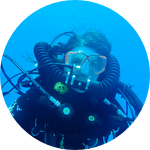About This Project
Diving data indicates that closed circuit rebreather fatalities increase with age, specifically around 40 years of age. The current hypothesis is that the increase in deaths is related to the cardiac load of diving. However, the causes of such cardiac events remain unclear, in part because data is hard to collect and in part because the cardiac load of diving has not been adequately studied. This study will perform underwater cardiac testing using COTS wearables.
Ask the Scientists
Join The DiscussionWhat is the context of this research?
Diving presents unique physiological challenges that require a comprehensive understanding to ensure diver safety and optimize performance (Foster & Sheel, 2005; Mier & Kegeles, 2002; Matuszak & Cooper, 2019). Cardiac load has been particularly identified as a cause of accidents and death, notably by Divers Alert Network (DAN). (DAN Annual Fatalities Report, 2012-2015, 2018, 2020; Trout et al., 2016). However, real-time cardiac data remains elusive and has not been compiled, let alone studied. For instance, while it is known that humans experience a mammalian reflex underwater, it is unclear how this affects the heart. (Panneton, 2013; Vincenzi, 2019). Based on this, there is increasing interest in studying the cardiac responses of underwater diving.
What is the significance of this project?
To date, there are no civilian real-time recordings of cardiac response to elevated cardiac demands while diving on a rebreather. This project would shed light on heart rate underwater, notably, heart rate during exertion and maximum heart rate achieved while engaging in maximum physical demands. Of importance, it would start answering questions about whether the underwater environment makes it harder for the heart to adequately respond. This, in conjunction with known underwater fluid shift to center mass could yield a hypothesis as to the increase in cardiac events after a certain age. If the heart is overloaded by the fluid shift caused by immersion, and it is unable to achieve its baseline heart rate, it could be a cause of heart failure.
What are the goals of the project?
The goals of this project are to establish VO2 Max for the subjects, and subsequently ask them to conduct two dives. The first dive will be at 10m, which only doubles pressure. Each subject will be asked to swim 400m at a calm pace and then 400m at the hardest pace they can manage. Each 100m length will be measured in time and hart rate will be monitored the entire time. Subjects will then be asked to repeat the exercise at 30m.
The ultimate goal is to create a baseline of cardiac responses to depth and level of exertion.
Budget
The above budget items are a subpart of the overall costs of the project. Our company, C2Space Tech LLC, will be contributing approximately $6,000 in fees and personnel in-kind contributions. More specifically, C2Space will cover $3,000 for IRB approval, given this is human testing, and safety divers in the water with the subjects. In addition, C2Space will fund data analysis, as needed.
The above listed items above would allow us to put 24 divers in the water, 6 at a time, over two days. Each diver would have a rebreather and two bailout tanks, performing two dives, back to back.
Each diver would be equipped with a Garmin watch and a Garmin chest strap to measure cardiac activity during the dives. The dive profiles consist of the following:
- Dive 1: 10 m depth, 400 m swims (one easy, one as fast as possible)
- Dive 2: 30 m depth, 400 m swims (one easy, one as fast as possible)
Endorsed by
 Project Timeline
Project Timeline
Once funded, the project will be submitted to an IRB and a Dive Control Board. Assuming swift approval, the project will begin in July 2024. We expect to complete the study in July 2024 and proceed with data analysis which will take another 60 days. Final draft of the study should be completed by December 2024.
Apr 26, 2024
Project Launched
Jul 05, 2024
IRB Approval
Jul 31, 2024
Travel to Florida; study takes place
Sep 30, 2024
Complete Data Analysis
Dec 13, 2024
Finalize Draft Article and Submit for Publication
Meet the Team
Team Bio
Dr. Jonathan Clark, Co-Founder and Partner's is a seasoned veteran with a vast array of qualifications in various military and aerospace roles, has dedicated a significant portion of his career to serving the U.S. Navy and NASA. He accrued extensive experience during his military tenure, including roles such as a naval flight officer, naval flight surgeon, U.S. Navy diver, U.S. Army parachutist, and special forces military freefall parachutist.
Maria-Vittoria Carminati
I was a lawyer for 15 years but everything changed when I saw a Humpback whale in Hawai'i in 2020. I am turning my efforts to scientific research.
In 2020, I went back to school to obtain a Bachelor's in Ecology and Evolutionary Biology with a Minor in Molecular, Cellular, and Developmental Biology. I am now a PhD student in Evolutionary Biology at CU Boulder and I am leading efforts to study speciation and hybridization as a response mechanism to climate change.
In addition, I am CEO of C2Space Tech LLC, a company that provides research and consulting for humans in the loop in high consequence environments (from underwater to high altitude and beyond).
I am fortunate to be able to work with tremendous bioinformaticians, physicians, and engineers across the continent who have been willing to guide, assist, and contribute.
I am also a scuba diving instructor, a sailor, and an adventurer at heart.
Lab Notes
Nothing posted yet.
Additional Information
A proof of concept was already conducted in Pensacola, FL. Dive profiles and logistics are now set. Locations and personnel are also well-defined.
Project Backers
- 1Backers
- 1%Funded
- $10Total Donations
- $10.00Average Donation

